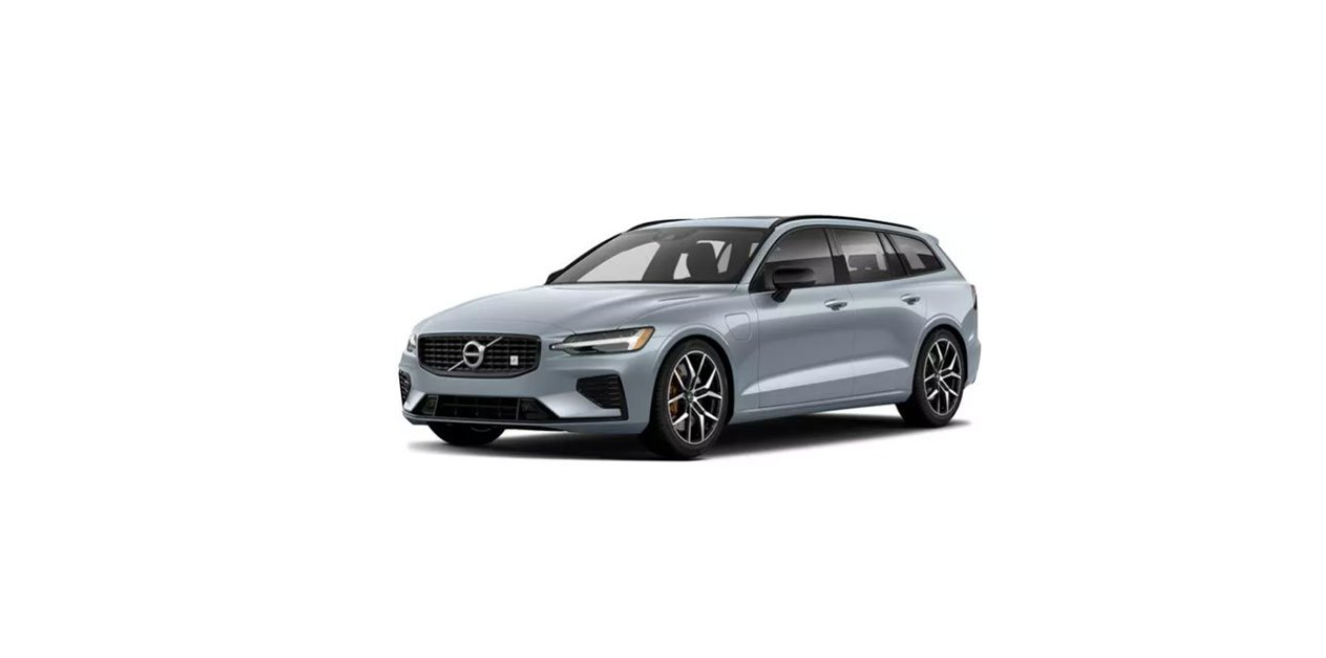2022 Volvo V60 Starting and switching off the car
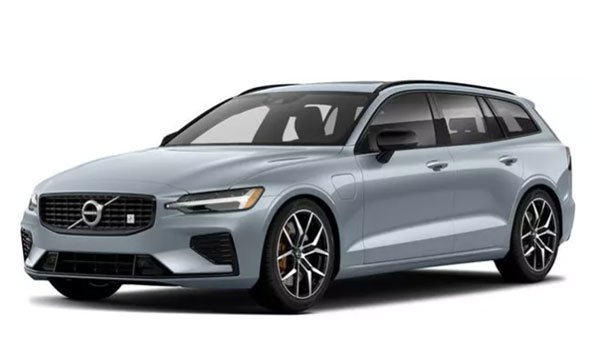
Immobiliser
The electronic immobiliser is a theft protection system that prevents starting the car without the correct key.
The following error message in the driver display is related to the electronic immobiliser:
| Symbol | Message | Specification |
|---|---|---|
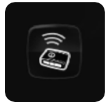 |
Car key not found | Error reading the key during starting – place the key on the key symbol in the cup holder and try again. |
Starting the car
The car is started using the start knob in the tunnel console when the key is in the passenger compartment.
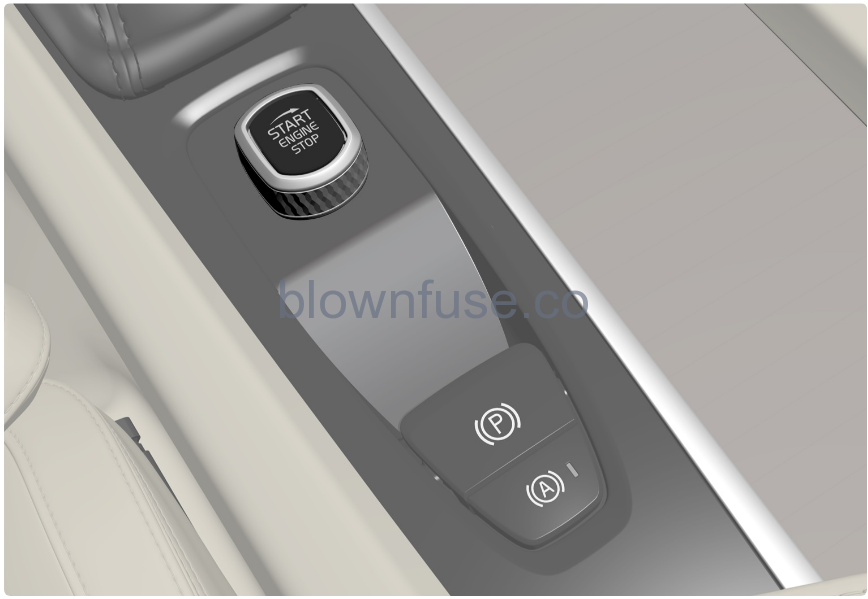 Start knob in the tunnel console.
Start knob in the tunnel console.
Warning
Before starting:
- Fasten the seatbelt.
- Adjust the seat, steering wheel and mirrors.
- Make sure that the brake pedal can be fully depressed.
The key is not physically used when starting the car since it is equipped with support for keyless starting (Passive start).
To start the car:
The key must be inside the car. For cars with Passive Start, the key needs to be located in the front part of the passenger compartment. With the option for keyless locking/unlocking of the car, the key can be anywhere in the car.
Hold the brake pedal fully depressed and make sure that gear position P or N is selected.
Turn the start knob clockwise and then release it. The control automatically returns to its starting position.
Note
For diesel-engined cars, there may be a slight delay before starting is initiated.
When the engine is started, the starter motor works until the engine is started or until its overheating protection triggers.
Error messages
If the Car key not found message is shown in the driver display when starting, place the key by the back-up reader. Then try to start the car again.
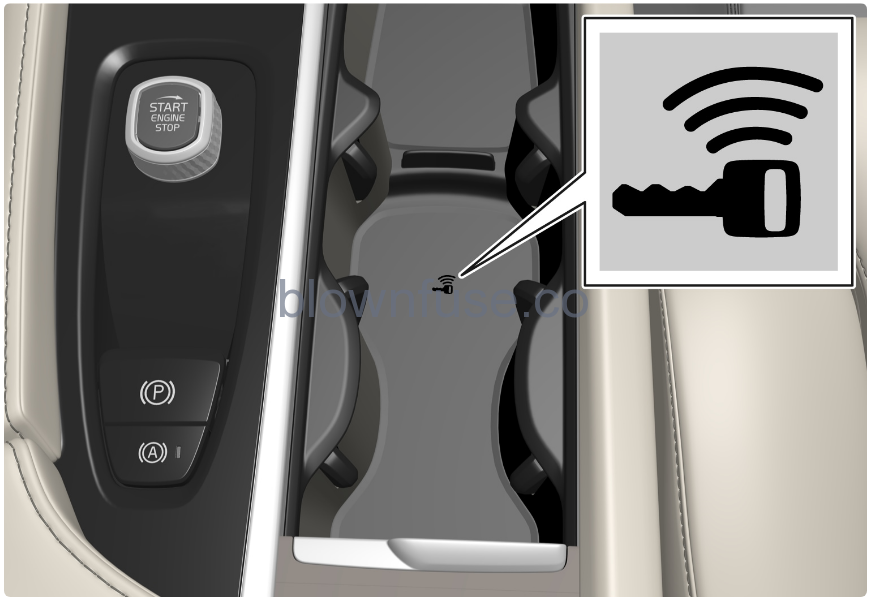 Backup reader’s location in the tunnel console.
Backup reader’s location in the tunnel console.
Note
When the key is positioned by the back-up reader, make sure that there are no keys, metal objects or electronic apparatus by the back-up reader, (e.g. mobile phones, tablets, computers or chargers). Several keys close to one another by the back-up reader may cause interference with each other.
Important
If the engine fails to start after 3 attempts – wait for 3 minutes before making a further attempt. Starting capacity increases if the battery is allowed to recover.
Warning
Never remove the key from the car while driving or during towing.
Warning
Always take the key out from the car when leaving the car and make sure the car’s electrical system is in ignition position 0 – especially if there are children in the car.
Note
The idling speed can be noticeably higher than normal for certain engine types during cold starting. This is done in order that the emissions system can reach normal operating temperature as quickly as possible, which minimises exhaust emissions and protects the environment.
Using jump starting with another battery
If the starter battery is discharged then the car can be started with current from another battery.
Jump starting requires access to another car’s 12V battery as well as jump leads.
Important
The charging points in mild hybrid type cars are designed for only jump starting the car itself. Do not use the charging points of mild hybrids to start other cars – the fuse for the charging circuit may be overloaded so that it stops working.
In mild hybrid type cars, a discharged starter battery may be caused by an overloaded fuse that prevents charging. If a fuse has been triggered, the message 12 V Battery Fuse failure Service required is shown in the driver display. Volvo recommends that an authorised Volvo workshop is contacted.
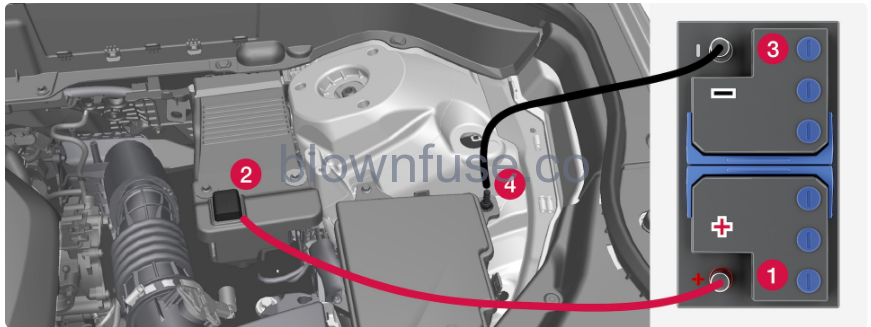 Charging points for jump starting own car. The appearance in the engine compartment may vary depending on car model and equipment level.
Charging points for jump starting own car. The appearance in the engine compartment may vary depending on car model and equipment level.
When jump-starting the car, the following steps are recommended to avoid short circuits or other damage:
- Set the car’s electrical system in ignition position 0.
- Check that the donor battery has a voltage of 12 V.
If the battery is installed in another car – switch off its engine and make sure that the cars do not touch each other.
Connect one of the red jump lead’s clamps to the donor battery’s positive terminal (1).
Important
- Connect the jump lead carefully to avoid a short circuit and contact with other components in the engine compartment.
- Open the positive charging point’s cover (2).
- Attach the red jump lead’s other clamp onto the car’s positive charging point (2).
- Attach one of the black jump lead’s clamps to the donor battery’s negative terminal (3).
- Attach the black jump lead’s other clamp onto the car’s negative charging point (4).
- Check that the jump lead clamps are affixed securely so that there are no sparks during the starting attempt.
- Start the engine of the donor car and allow it to run for a few minutes at a rotation speed higher than normal idle approx. 1500 rpm.
- Start the engine in the car with the discharged battery.
Important
Do not touch the connections between cable and car during the starting attempt. There is a risk of sparks forming.
Remove the jump leads in reverse order – first the black and then the red.
Make sure that none of the black jump lead’s clamps comes into contact with the car’s positive charging point, the donor battery’s positive terminal, or the clamp connected to the red jump lead.
Warning
48 V voltage can be dangerous in the event of incorrect intervention. Do not touch anything on the batteries that is not clearly described in the owner’s manual.
- 48 V support battery must never be used for jump starting.
- External electrical equipment must not, under any circumstances, be connected to the 48 V battery.
- The 48 V battery may only be serviced and replaced by a workshop – an authorised Volvo workshop is recommended.
Warning
- The battery can generate oxyhydrogen gas, which is highly explosive. A spark can be formed if a jump lead is connected incorrectly, and this can be enough for the battery to explode.
- Do not connect the jump leads to any fuel system component or any moving part. Be careful of hot engine parts.
- The battery contains sulphuric acid, which can cause serious burns.
- If sulphuric acid comes into contact with eyes, skin or clothing, flush with large quantities of water. If acid splashes into the eyes – seek medical attention immediately.
- Never smoke near the battery.
Note
If the starter battery has such a low State Of Charge (SoC) that the car has no normal electrical functions and the engine is then jump-started with an external battery or a battery charger, the Start/stop function may continue to be activated. If the Start/stop function then auto-stops the engine shortly afterwards, there is a great risk that engine auto-start will fail because the battery has not had the time to recharge sufficiently.
If the car has been jump-started, or if there is insufficient time to charge the battery using a battery charger, the Start/stop function will be temporarily deactivated until the battery has been sufficiently recharged by the car. In an outside temperature of approx. +15 °C (approx. 60 °F), the battery needs to be charged for at least 1 hour by the car. In a lower outside temperature, the charging time may increase to 3–4 hours. The recommendation is to charge the battery if possible using an external battery charger.
Switching off the car
The car is switched off using the start knob in the tunnel console.
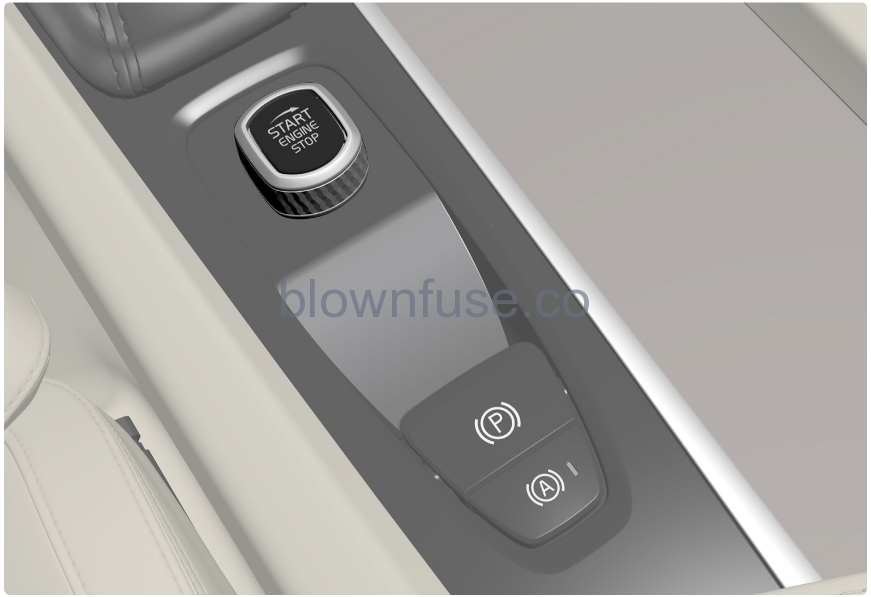
- Start knob in the tunnel console.
To switch off the car:
- Turn the start knob clockwise and release it – the car is switched off. The control automatically returns to its starting position.
- If the gear selector for cars with an automatic gearbox is not in position P or if the car rolls:
- Turn the knob clockwise and hold it until the car is switched off.
Ignition positions
The car’s electrical system can be set in different levels/positions and in this way make the different functions available.
In order to facilitate the use of a limited number of functions with the engine switched off, the car’s electrical system can be set in three different levels – 0, I and II. These levels are described with the denomination “ignition position” throughout the owner’s manual.
The following table shows the functions available in each ignition position/level:
| Level | Functions |
|---|---|
| 0 |
In this mode, the functions are controlled by time and are switched off automatically after a short while. |
| I |
Power is taken from the battery in this ignition position. |
| II |
This ignition position consumes a lot of current from the battery and should therefore be avoided! |
Selecting ignition mode
The car’s electrical system can be set in different levels/positions and in this way make the different functions available.
Selecting ignition position
 Start knob in the tunnel console.
Start knob in the tunnel console.
- Ignition position 0 – Unlock the car and store the key inside the car.
Note
To reach level I or II without starting the engine – do not depress the brake pedal when these ignition positions are to be selected.
- Ignition position I – Turn the start knob clockwise and release it. The control automatically returns to its starting position.
- Ignition position II – Turn the start knob clockwise and hold it in position for approx. 5 seconds. Then release the knob, which automatically returns to its starting position.
- Back to ignition position 0 – To return to ignition position 0 from position I and II – Turn the start knob clockwise and release. The control automatically returns to its starting position.
